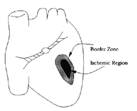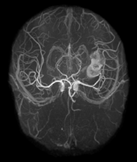Take Two Algorithms and Call Me in the Morning: Mathematical Medicine at SIAM50
September 6, 2002

Figure 2. A proposed mechanism for the fibrillation that follows heart attacks in some people has chemical and electrical properties of damaged (ischemic) cells interfering with the electrical activity of marginally healthy cells in the surrounding border zone.
It's usually not a good sign when a heart surgeon wants to see you. Even worse is a call from a brain surgeon. But for Chris Johnson and James Keener of the University of Utah, being summoned for a surgical consultation is a welcome event. That's because the scalpel set wants to pick their brains, not open them up.
Johnson and Keener gave invited talks in July at the SIAM 50th Anniversary Meeting in Philadelphia. Johnson, who directs the Scientific Computing and Imaging Institute (SCI) at the University of Utah, spoke on the role of visualization in biomedicine and the need for researchers to pay attention to the entire computational "pipeline" when developing software. Keener, a professor of mathematics, described a new mathematical model that may finally give cardiologists the answer to an age-old question: What causes fibrillation in the wake of a heart attack?
Math Brains
"It would be interesting for science to watch the mental changes of individuals, on the spot."---Joseph Conrad, Heart of Darkness
Johnson began his PowerPoint presentation with a stunning black and white image of the vascular system of a patient's brain, complete with an ominous, peanut-sized aneurysm (see Figure 1).


Figure 1. After studying animated 3D images of the vascular system of a patient's brain, surgeons modified their approach and successfully removed the aneurysm visible in the middle of the right-hand side in each of the images shown here (top photo, view from the top; bottom photo, from the front). Images from the Scientific Computing and Imaging Institute at the University of Utah.
The snapshot became even more stunning when it began to rotate, revealing the system's three-dimensional structure. (The animation is available online in the image gallery at the SCI Web site, http://www.sci.utah.edu/.) For the neurosurgeons who had requested it, there was yet more: The 3D image was interactive---the surgeons could "fly through" the patient's brain---and in stereo.
After studying the animated image, Johnson says, the surgeons changed the attack they had originally planned on the basis of standard 2D images. "We became value added," Johnson says. "We were able to do something that they couldn't do before." (The patient survived a successful operation, Johnson reports.)
This new way of visualizing things did not require any new medical technology. The aneurysm image came from ordinary magnetic resonance (MR) data. Stripping away the scalp, skull, and brain matter, leaving only the vascular system on view, is a standard technique (although, Johnson points out, there are still open research problems in image segmentation, which underlies the process). For that matter, assembling a 3D picture from 2D slices is routine. What's new, Johnson explains, is the high resolution of the image and the ability to interact with it in stereo. These features come at a cost, he adds: "It ends up being a gigabyte or more of data that you're having to visualize."
All this is only now becoming possible, because of advances in algorithms and hardware---and because cross-disciplinary researchers are working together more closely than ever. "The algorithms have gotten sophisticated enough and the computers have gotten just fast enough, where we're just barely able to overcome that barrier of complexity of the human body," Johnson says. To get over the hump "takes expertise from multiple sides."
It also means taking a big-picture view of the computational "pipeline," he adds. Traditionally, computational scientists and engineers approach problems by breaking them up into pieces and then finding the best way to handle each piece. But all too often the separate "best" algorithms wind up using data formats that don't match---the computational equivalent of a railway system made up of tracks of different widths. (It's been pointed out that one of the reasons the American South lost the Civil War is that its railroads ran on tracks of three different gauges.) The complex problems now being addressed require researchers to develop a computational infrastructure that facilitates the assembly of pieces.
"This of course requires that you pay attention to how you create your software," Johnson cautions.
SCI researchers are creating just such an infrastructure in what they call Problem Solving Environments (PSEs). These software packages serve as computational "workbenches," enabling the scientists and engineers working on a project to do interactive simulations and visualizations within a consistent computational framework. The main package, SCIRun, was developed by Johnson and Steven Parker, also at the University of Utah, in the mid-1990s. The aptly named BioPSE extends SCIRun with software modules geared for problems involving bioelectric fields.
Be Still My Beating Cardioid
One current BioPSE project involves modeling the human heart and torso for the study of implantable defibrillator devices. These devices have been around since 1980. The most famous recipient, Vice President Dick Cheney, is only one of roughly 35,000 people worldwide to have had such devices implanted last year. Fibrillation is the bad thing that happens to many people shortly after a heart attack (not of course a good thing either): The electrical activity of the heart, normally so nice and rhythmic, goes haywire, causing the contracting heart muscles to resemble a sack of worms-to be unproductive, in other words, in terms of pumping blood. Death is almost certain, unless the heart is defibrillated.
Defibrillation is performed through the application of electrical current to the heart. Introduced in 1947, the technique is now a staple of emergency medicine. If you haven't seen a doctor jam a pair of paddles against the chest of a patient and shout "Clear!" then you haven't been watching "ER." Defibrillators are standard equipment in hospitals and ambulances. They are also beginning to show up in sports stadiums and airports---places where stressed-out, overweight people are common.
The implantable version is considered desirable for people who, like Cheney, are considered at high risk for arrhythmia. The device consists of a battery, one or more electrodes in direct contact with the heart, and a tiny computer that monitors what the ticker is up to and whether it needs a little extra juice---or, if need be, a lot. Because of the direct contact, the implantable device can get by with less of a shock than an external defibrillator. But medical researchers are still fiddling with the design.
"That's where we come in," Johnson says. BioPSE makes it possible to model the electrical properties of the human torso, run simulations of different defibrillator designs, visualize the resulting electric fields, make changes in the design, and rerun the simulations, over and over. "You can do hundreds or thousands of design experiments in the computer and then take the best ones to the next level," he explains. The computational approach also sidesteps the ever-present ethical aspect of medical research: "You can't do these experiments on people, but you can on their digital counterparts."
The Utah group's defibrillator study is based on MR and CT data from a "prototypical" male patient. "At this point we're really trying to find what works best for a general population of heart patients," Johnson says. Devices customized for individual patients may be possible, he thinks, but "that's in the future."
BioPSE creates a digital model from the scans, using triangulated surfaces for the interfaces between skin, fat, muscle, lungs, and so forth, and a 3D mesh for the various volumes. Each subregion has a different electrical conductivity (blood, for example, conducts electricity approximately fifty times better than bone). The model must also include properties of the device, in particular the size, shape, and location of the elec-trode(s). The simulation then calculates the flow of electricity throughout the body when the device delivers a shock. "We're mainly interested in how effective it is at shocking the heart," Johnson says. The detailed BioPSE model should make it possible to improve the design, so that implantable defibrillators can do their job with less voltage, thereby making them safer and more reliable.
A Medical Mystery Solved?
"I have a little theory which you messieurs who go out there must help me to prove."---Heart of Darkness
What causes fibrillation in the first place? Given the hundreds of sudden cardiac deaths that occur each day in America alone, you would think cardiologists would have figured out the mechanism of fibrillation by now. In fact, they haven't. But Keener has come up with a hypothesis that's based on mathematical principles, and that suggests experiments to test it. Keener's hypothesis, which he has explored in joint work with his student Brad Peercy and with Sasha Panfilov of the University of Utrecht, is that fibrillation following a heart attack is the result of a border zone arrhythmia that leads to a breakup instability. All this, of course, requires elaboration.
To begin with, a heart attack occurs when the blood supply to some portion of the heart is cut off, causing ischemia: death of the cells in the involved region. Among the physiological effects of ischemia are increased potassium levels outside the cells, decreased pH levels inside, and a depletion of ATP, the molecular bio-battery that keeps things running. These changes affect the cells' electrical properties as well. (Even though the ischemic cells are dead or dying, they're not suddenly made of ceramic. The basic equations that describe their electrical activity continue to apply. It's just that the parameters are drastically different or changing dramatically.) The depleted ATP levels lead to increased activity in the potassium channels of the affected cells, which shortens the duration of their action potential-the time it takes them to return to their resting membrane potential.
All this interferes with the normal electrical activity of the marginally healthy cells in the "border zone" around the ischemic region (see Figure 2). In particular, the shortened action potential duration makes it possible, at least according to the equations, for a rapid-paced arrhythmia to cause a breakup instability, which is pretty much what it sounds like: a state of the system in which waves of activation break apart into a disorganized mess of tiny local waves. And that's exactly what fibrillation is.
The mathematical analysis that Keener and colleagues have carried out is interesting to cardiologists---interesting enough, Keener reports, that they've attended talks he's given for the Utah math department---because the hypothesis is both plausible and testable. The latter attribute is especially important. The theory makes specific predictions that suggest experiments. "This is something that a lot of mathematical theories lack," Keener points out.
The theory is new enough that the experiments haven't been done. "It's not been tested either experimentally or in detailed quantitative ways on detailed quantitative models," Keener says. That makes him optimistic, but cautious, about his hypothesis. "It's more right than anything else that exists, but it could still be very wrong."
"I don't know that anything I do will ever have direct clinical implications or applications," Keener adds. "What I do hope is that what I do will have fundamental scientific implications---that is, it will help us understand the science deeply." His fibrillation hypothesis may or may not hold up, but even if it doesn't, the falsification should lead to another, better explanation. "Our belief is that a fundamental understanding always helps," Keener says. "It's always better than not understanding!"
Barry A. Cipra is a mathematician and writer based in Northfield, Minnesota.

